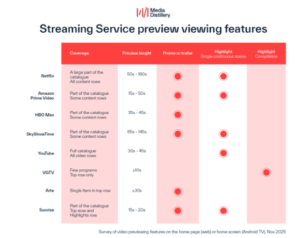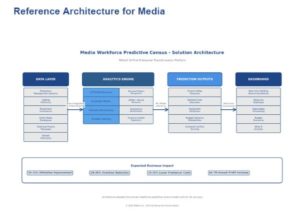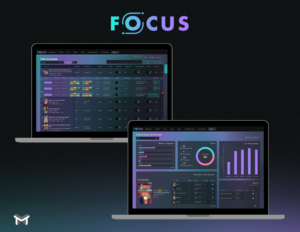When the CEO of Netflix forecasts the death of linear TV within the next 5-10 years, the growth plans of legacy providers suddenly take on added urgency. Critics argue that the 10-year prediction is – if you’ll pardon the pun – a little OTT. However, while the timeframe may be questionable, the direction of travel certainly isn’t. Right now, everyone’s on a journey to OTT. Getting there quickly requires an organisational agility that’s, at present, rare. So how do you develop it? This article sets out some key considerations.
But first, let’s establish some context. The OTT market continues to expand as a slew of major brands prepare to enter the space. Despite evidence that subscription growth is slowing, the streaming video (SVOD) market continues to climb – with global subscriptions tipped to reach 1.7bn by 2027. At the same time, revenues from ad-supported streaming (AVOD) are expected to double in the next five years as established players flex their models in response to consumer need. New formats are gathering pace too, not least FAST (Free Ad-supported Streaming TV) channels – linear streams accessed via electronic programming grids that allow viewers to join broadcasts in-progress. FAST channels are growing rapidly as consumers look for low-cost linear alternatives to TV.
The turbo-charged prelude
Make no mistake, Reed Hastings is right: there’s a road race to OTT and everyone’s hammering on the throttle because they know the clock is ticking. However, the race for the finish line isn’t straightforward, with many discovering the course is full of roadblocks. In particular, traditional providers – challenged by the imperative to embrace a new delivery model whilst at the same time maintaining legacy business – are finding the transition tough. Some, despite their best efforts, don’t have the capacity, the human capital or – crucially – the agility to get there quickly.
It isn’t easy. OTT delivery is like a never-ending action movie: it’s Fast and Furious. OTT journeys routinely travel through blind corners and lightning-quick chicanes that can easily crash the user experience (UX). Surviving them requires speed and agility. With UX key to retaining subscribers, failure to react quickly to problems can lead to an exodus of customers that’s difficult to recover from. Bottom line: if you don’t respond Fast, your customer may end up Furious.
The challenge for traditional providers is that OTT and broadcast media are two entirely different races – and trying to pivot from a fixed infrastructure to a more flexible environment requires a different skillset and an agile mindset. It takes time – but time’s running out.
The best OTT experiences are nimble and efficient. Sport is a great example of this. If you want to be a sports provider in the OTT space your environment simply has to be agile. Pay-per-view sport typically attracts a massive peak in demand in the lead up to an event as users sign up, with demand subsequently tailing off into a steady state as audiences settle down to watch. That sudden influx just moments before kick-off presents significant challenges. If you haven’t built an infrastructure that has the capacity to flex up and down in a smooth, quick fashion, there’s a good chance that when users tune in they’ll quickly be greeted with a 503 or 504 error, “Out of Resources” or “Gateway Time-out”. That’s the end of the road for the customer experience. Sports provision is unforgiving: if a customer misses kick-off, they invariably don’t return for the second half (both literally and metaphorically).
These challenges translate across all types of content. So how do you avoid them? The solutions are rooted in good engineering.
Engineering issues typically occur when organisations don’t fully understand how the various components in the OTT delivery chain interact or can’t identify the specific components that are causing them issues. Given the polarity between legacy and OTT environments, these gaps in knowledge are entirely understandable – but addressing them is key.
The fast-track to success often comes from working with a tech agnostic, independent partner that knows how the myriad components – sign-up, entitlements, restrictions, billing, payment systems etc – work together in the back end, and can show you which are most likely to be creating bottlenecks. From there it becomes easier to design solutions that de-risk potential problems and provide the speed and agility to flex at scale.
The Fast Saga
So how do you build the agility to support the rapid deployment of OTT services? Fundamentally, agility is a mindset that pervades every aspect of an organisation and its products. When it comes to delivering OTT services, there are three core components of a business where agile thinking must be part of the DNA.
#1. Infrastructure/architecture
Infrastructure design is the start-line of the race. If your engine isn’t wired properly, you’ll struggle to move through the gears. It’s important to plan for the whole journey. Many companies make the mistake of designing for the ‘happy path’ where everything works well. But what happens when things go wrong? Because they will. Smart organisations are proactive, identifying ‘edge case’ problems that could potentially occur and engineering their architecture to address them from day one. You cannot predict them all but a number can easily be catered for up front. For example, what do you do when payment or geolocation services fail? What happens when you have a spike in customers or internet capacity issues? What do you do when one of your vendor services crashes and customers are being blocked from entry?
There are countless problems that can (and will) crop up. Many can be de-risked with agile, up-front thinking. Most organisations don’t think through all the potential scenarios. Those that do typically end up with an infrastructure that has a certain amount of agility in-built to cope with the everyday stresses of OTT delivery. That invariably leads to better engineering, a better user experience and happier customers.
#2. People
Organisations are at full stretch. Most are operating with small teams that don’t have the capacity to suddenly switch focus to deliver new projects, yet businesses are demanding rapid advances towards OTT. Unfortunately, many don’t have the people, the skillsets or the agility in-house, but the pace of change is accelerating faster than they can recruit. This is preventing companies from getting new products over the line, impacting everything from infrastructure and architecture to UX and UI design.
The most effective leaders recognise they don’t have everything they need in-house and are open to working with partners that can provide the speed, agility and expertise they’re missing. This agile mindset is often determinative to executing plans and meeting customer and shareholder expectations.
Agile partners can often be deployed on a short-term or project basis, either supplementing delivery teams or working as an independent unit. The most effective adapt to the culture and needs of the client business, providing flexibility and expertise to support the rapid deployment of OTT services.
#3. Financial modelling
Companies are becoming much more open in how they model their financing for tech projects. Whether it’s CapEx, OpEx, software-as-a-service or something more customised, organisations have recognised that the nature of tech services has evolved and the way that they pay for them can enhance their agility. The best approach is not to be too fixed in your financial modelling but instead ask yourself whether the stuff you’re buying is core IP for your business. If it isn’t, it’s worth considering options that give you the flexibility to change direction as the business or market evolves.
Shortcut to success
The road to OTT is like a high-speed action movie fraught with danger. The pace of change – just like the real-time demands of OTT delivery – is Fast and Furious, while the race for the finish line before businesses become irrelevant only adds urgency to the journey ahead. One of the most effective shortcuts to winning the race is to find a driving partner that can help steer you on the right track, and give you the agility to manoeuvre between the traffic to deliver platforms that delight customers at speed and scale. It’s time to put the pedal to the metal and go full throttle towards OTT.









